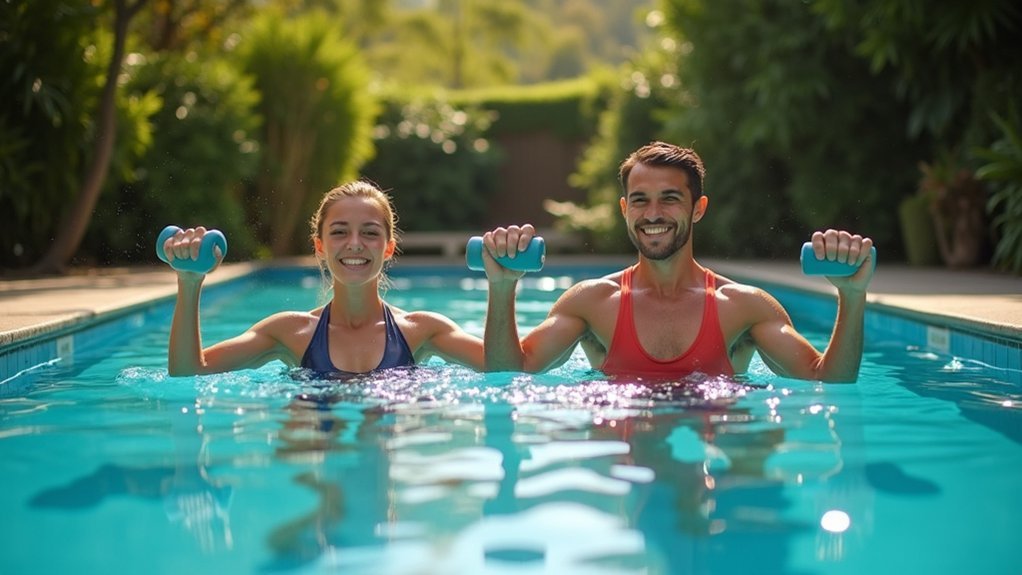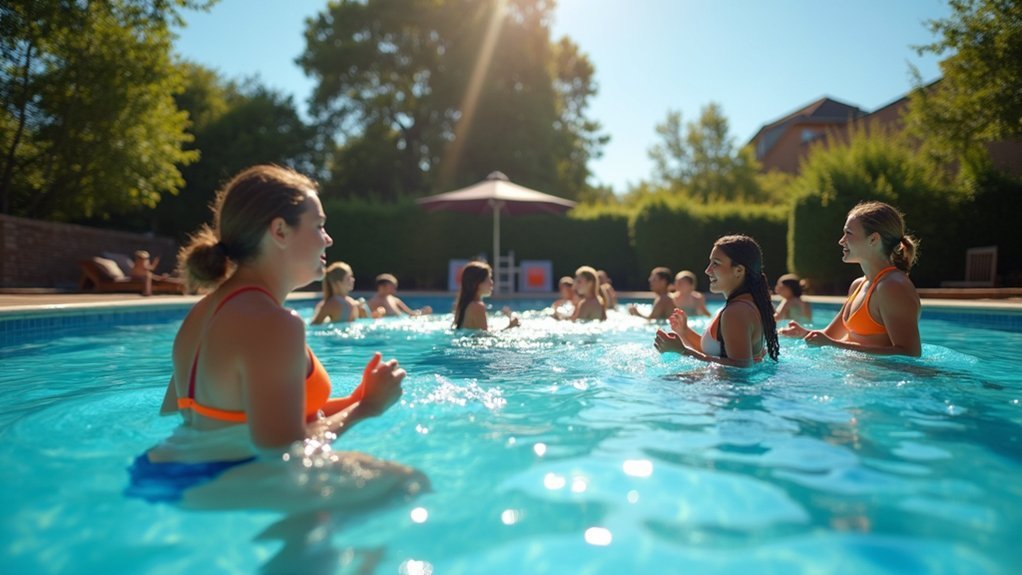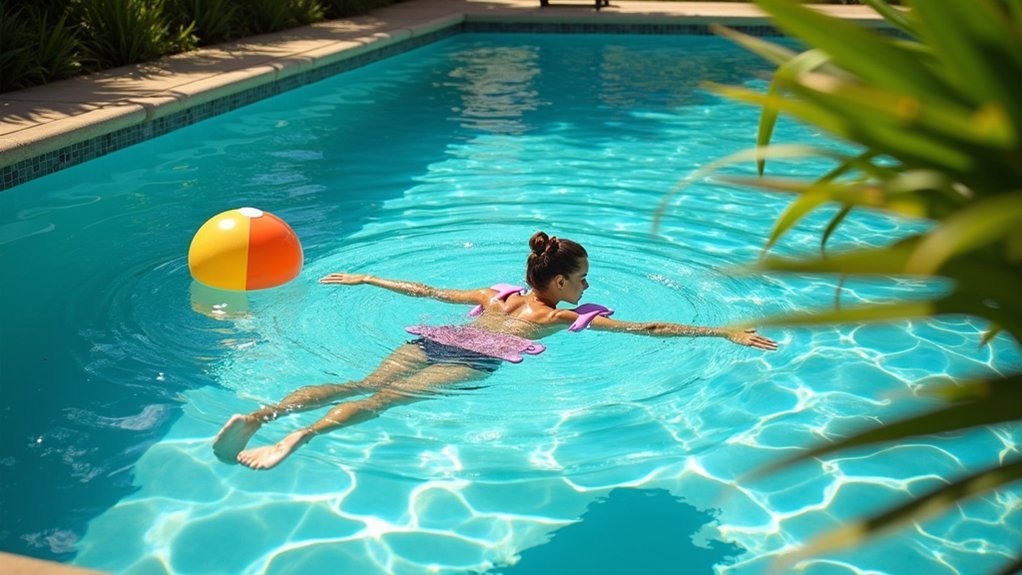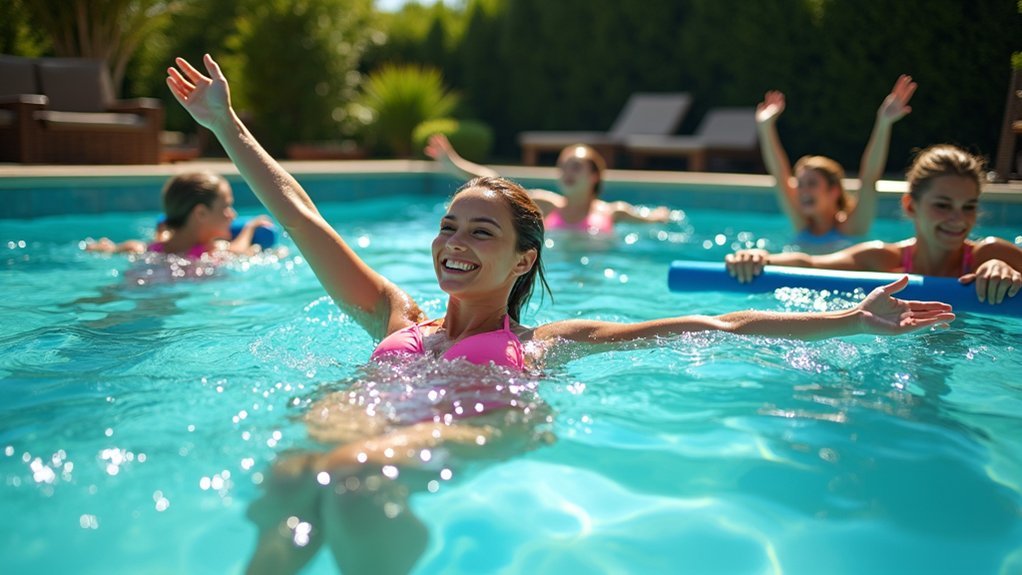Pool exercises can greatly reduce MS symptoms while providing low-impact workouts. Try water walking for improved mobility, aquatic stretching to ease spasticity, water weights for strength building, and balance exercises that minimize fall risks. For heat sensitivity, keep pool temperatures below 85°F and use cooling garments. Flotation therapy helps those with advanced MS, while personalized routines guarantee you’re targeting your specific needs. These seven techniques offer relief that extends far beyond your time in the water.
Water Walking: The Low-Impact Path to Improved Mobility

Five key benefits make water walking an ideal exercise for those managing multiple sclerosis.
The buoyancy of water considerably reduces strain on your muscles and joints while allowing greater freedom of movement. You’ll experience the benefits of exercise without the gravitational stress that often exacerbates MS symptoms. The warm water therapy relaxes tense muscles and alleviates discomfort often experienced by MS patients.
You don’t need swimming skills to participate in water walking, making it accessible regardless of your aquatic comfort level.
The water’s natural resistance strengthens your muscles as you move, improving balance and coordination over time. The cool temperature helps manage heat sensitivity, a common MS challenge.
Regular water walking in just an 8×8 foot space can enhance your mobility, independence, and quality of life while providing a supportive environment for pain-free movement.
Aquatic Stretching: Gentle Relief for Muscle Spasticity
You’ll find remarkable relief from muscle spasticity through targeted aquatic stretching techniques that gently ease stiffness.
The water’s natural buoyancy supports your body, allowing for smoother movements and improved flexibility without stressing your joints.
Warm water temperatures between 92°F to 94°F enhance these benefits by naturally soothing tight muscles and increasing blood flow to areas affected by MS symptoms. Hydrostatic pressure helps reduce unwanted swelling in joints and soft tissues, which is particularly beneficial for MS patients experiencing inflammation-related discomfort.
Stretching Techniques Reduce Stiffness
Water’s natural buoyancy creates an ideal environment for MS patients to stretch tight muscles with less strain and greater comfort.
In the pool, you’ll experience reduced muscle tension as your body feels lighter, making it easier to perform stretches without overexertion.
Try passive stretching by slowly moving affected joints and holding each position for about a minute.
Combine these movements with deep, calming breaths to enhance relaxation and further reduce muscle tension.
Focus on range of motion exercises to maintain joint mobility and decrease your risk of contractures.
You don’t need swimming skills to benefit from these techniques.
The temporary relief from spasticity can help manage your symptoms throughout the day, though duration varies based on your condition’s severity and the specific stretches you perform.
Flexibility exercises like water yoga can significantly improve your range of motion while maintaining a comfortable body temperature.
Water Warmth Soothes Muscles
Immersing yourself in warm water provides exceptional therapeutic benefits for MS patients struggling with muscle spasticity. The warmth effectively reduces muscle tone while enhancing relaxation in tight, painful areas.
When you enter a pool kept below 85°F, you’ll experience immediate relief as the water’s buoyancy supports your body weight, decreasing pressure on joints and making movement easier.
This therapeutic environment elevates your pain threshold while simultaneously reducing stiffness. The thermal stimulation increases blood flow to affected muscles, offering natural relief without medication side effects.
Research shows just 15 minutes of exposure to warm water at 31 degrees Celsius can significantly improve muscle flexibility and reaching ability.
You’ll find that warm water therapy combines the dual benefits of temperature and buoyancy, creating ideal conditions for gentle stretching exercises that might be too difficult on land.
Many MS patients report lasting relief from spasticity after regular warm water sessions.
Resistance Training With Water Weights: Building Strength Without Strain

Water resistance training offers you effective upper body workouts through specialized aquatic weights, webbed gloves, and controlled pushing movements against the water.
You’ll strengthen your legs with water-based lunges, knee lifts, and sideways walking exercises that challenge muscles without stressing your joints.
These strength-building techniques take advantage of water’s buoyancy and variable resistance, allowing you to adjust intensity by simply changing your movement speed. Maintaining proper knee alignment during squats and other resistance exercises helps ensure maximum benefit while minimizing injury risk.
Upper Body Resistance Techniques
Four effective resistance techniques can transform your pool sessions into powerful upper body workouts while protecting your MS-affected muscles.
Water dumbbells amplify resistance during exercises, challenging arm and shoulder muscles without causing excessive strain.
Hand paddles increase water resistance when pushing or pulling, effectively targeting chest and shoulder muscles during movements like pistons and chest presses.
For versatile training, resistance bands attached to pool sides create customizable tension for lateral shoulder raises and rotational exercises.
The water itself provides variable resistance—move faster and you’ll feel greater intensity. This natural property lets you adjust workout difficulty instantly without changing equipment.
Remember to use pool edges for balance assistance when needed, and always allow sufficient recovery time between sets to manage MS-related fatigue.
The ideal water temperature of 80 to 84 degrees Fahrenheit helps prevent overheating that can worsen MS symptoms during your resistance training.
Leg Strengthening Movements
While managing MS symptoms, leg strengthening in water offers unique advantages that traditional gym exercises can’t match. The pool’s buoyancy reduces joint strain while water provides natural resistance for building muscle. The hydrostatic pressure of water promotes better circulation and can help reduce swelling in the legs during exercise.
Try water walking in different directions to engage various leg muscles. Add lunges and squat jumps—these movements strengthen your glutes, quads, and hamstrings with minimal impact.
For deeper water exercises, simulate bicycling to work your legs without ground support.
Use equipment to enhance your workout: pool noodles for balance, kickboards for resistance, or water weights during side steps to target hip abductors. If needed, modify by holding the pool edge.
Research shows these exercises improve balance and reduce fatigue. Aim for 150 minutes weekly, but consult your physical therapist for a personalized plan.
Balance Enhancement Exercises: Staying Steady in the Pool
For people with multiple sclerosis, maintaining balance often presents a significant challenge, yet the pool offers an ideal environment to practice stability safely. The water’s buoyancy supports your body while minimizing fall risks, allowing you to confidently work on balance skills.
Try walking forward, backward, and sideways in chest-deep water to improve mobility and gait. Incorporate one-legged stands while holding the pool edge for support. As you progress, add aquatic aerobics that challenge your coordination through multidirectional movements.
Core-strengthening exercises like gentle twists and water planks provide essential stability. Studies from the meta-analysis found that aquatic therapy provided significant enhancement of static balance in MS patients. The natural resistance of water strengthens supporting muscles without stressing your joints.
Research consistently shows these exercises improve both static and dynamic balance on standardized measures like the Berg Balance Scale.
Cooling Techniques: Managing Heat Sensitivity While Exercising

Heat sensitivity represents one of the most challenging aspects of multiple sclerosis, as elevated body temperature can temporarily worsen symptoms and impair physical function.
The good news is that pool exercises offer an excellent solution. Water conducts heat better than air, helping dissipate your body heat effectively during workouts. Unlike exercising on land where poor heat conduction in air can make temperature management difficult, water-based activities provide natural cooling.
For ideal temperature management during pool exercises:
- Choose pools maintained between 32-34°C (or under 85°F) to prevent overheating while still providing therapeutic benefits
- Wear cooling garments like specialized vests, neck wraps, or wristbands before and during exercise sessions
- Schedule your pool workouts during cooler parts of the day (mornings or evenings) to minimize heat-related symptom exacerbation
Remember that symptoms triggered by heat typically resolve once your body temperature normalizes, so don’t let heat sensitivity prevent you from enjoying the neuroprotective benefits of exercise.
Flotation-Assisted Movement Therapy for Advanced MS
When mobility becomes severely limited in advanced MS, flotation-assisted movement therapy offers a revolutionary approach to exercise. The buoyancy of water dramatically reduces joint strain while making movement possible again for compromised muscles.
In float tanks, you’ll benefit from both the therapeutic properties of Epsom salt and the reduced gravity environment. The magnesium absorption helps relax tight muscles and decrease pain, while simultaneously reducing inflammation. The high concentration of 500kgs of Epsom Salt creates an optimal therapeutic environment for MS patients.
This environment can improve your motor control by minimizing involuntary muscle contractions. Research shows flotation therapy’s benefits may increase over time, with positive effects lasting up to four months after treatment.
You’ll likely experience improved sleep quality, increased serotonin levels, and significant stress reduction—all essential factors in managing advanced MS symptoms and potentially improving your overall quality of life.
Creating Your Personal Aquatic Exercise Routine

Building on the benefits of water therapy, a personalized aquatic exercise routine offers you maximum therapeutic value while addressing your specific MS symptoms.
Start by consulting a physical therapist who specializes in aquatic therapy for MS to design a program tailored to your capabilities and goals.
- Set realistic goals focusing on specific improvements like balance or strength, and allow yourself time to progress gradually.
- Choose pool temperatures between 80-88°F to prevent overheating while maintaining comfort for movement.
- Monitor your fatigue levels closely during sessions, incorporating rest periods and adjusting intensity as needed. The buoyancy of water significantly reduces weight on your joints during submersion, making movements easier to perform even when fatigue sets in.
Remember to communicate regularly with your instructor about how you’re feeling, and don’t hesitate to modify exercises when necessary.
Your routine should evolve as your symptoms change or as you build strength.
Frequently Asked Questions
What Water Temperature Is Optimal for MS Aquatic Exercise?
For MS aquatic exercise, you’ll want pool temperatures below 85°F (29°C), ideally between 77-81.5°F (25-27.5°C). This cooler range prevents overheating while allowing you to gain strength and exercise tolerance benefits.
How Do Chlorine and Pool Chemicals Affect MS Symptoms?
Chlorine and pool chemicals can worsen your MS symptoms by irritating skin, triggering respiratory issues, and increasing sensitivity. You’ll want to shower immediately after swimming and consider pools with alternative sanitizing systems like saltwater.
Can Aquatic Exercise Help With Ms-Related Bladder Control Issues?
While research is limited, aquatic exercise may indirectly help your MS-related bladder control by improving core strength, reducing overall stress on your body, and enhancing mobility that supports better general symptom management.
Should I Exercise During an MS Relapse or Flare-Up?
During an MS relapse, you shouldn’t exercise strenuously. Consult your healthcare provider first, then consider only low-intensity activities if approved. Rest more, stay hydrated, and modify your routine until your symptoms improve.
How Does Aquatic Therapy Compare to Land-Based Physical Therapy?
Aquatic therapy offers reduced joint stress, pain-free movement, and gentler resistance compared to land-based therapy. You’ll benefit from water’s buoyancy while still building strength, making it ideal for those with mobility challenges.
In Summary
You’ve now discovered seven powerful pool exercises that can greatly reduce your MS symptoms. Whether you’re walking in water or doing flotation therapy, these aquatic routines offer relief without overheating your body. Remember, you don’t need to tackle all exercises at once. Start slowly, listen to your body, and you’ll find that water workouts can become an essential part of managing your MS journey effectively.





Leave a Reply